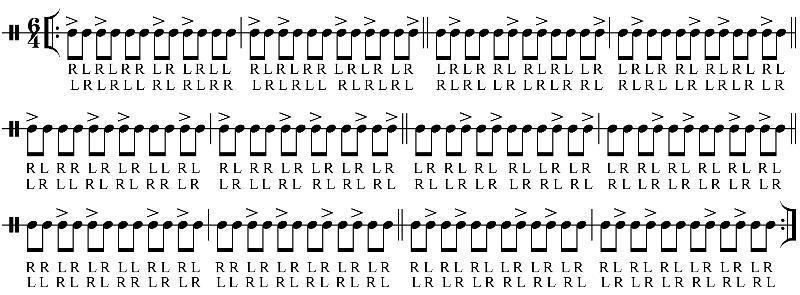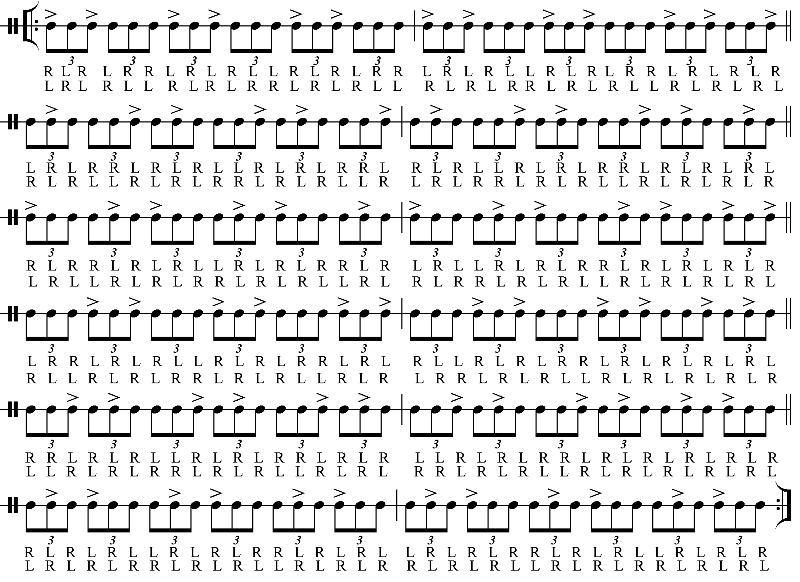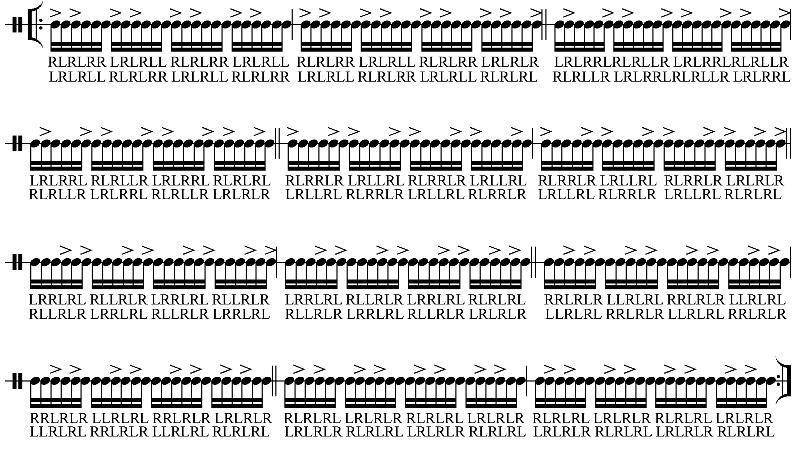by
Rhythm Scene Staff
| Apr 05, 2021
In a previous R!S Hotlick, I explained an exercise I call the Paradiddle Freak-Out! The exercise was intended to help drummers take paradiddles to a higher level of consistency, control, and speed. The Freak-Out! also uncovered some valuable groove and solo ideas that the paradiddle sticking provides on the drum set.
We can improve our technique and expand drum set vocabulary in totally new ways by applying those principles to the double paradiddle as well. Here is the basic pattern for the Double Paradiddle Freak-Out! As in the original, each accent shift occurs by dropping a note, so think ahead.

The most awkward parts of the Freak-Out! occur when the accents fall on the “ands” of the beat. Place an imaginary accent (inaudible) on beat 1 throughout the exercise to keep the accents from shifting to the beat. Better yet, grunt or say “one” or “dut” on beat 1 to solidify the groove. Beyond the Freak-Out!, this habit of imagining a loud beat one can help you to execute syncopated and polyrhythmic ideas much more comfortably and will strengthen your groove.
After you have mastered the basic sticking, proceed to part two, which moves the pattern to eighth-note triplets.

In part three, we set the sticking and accent pattern over sixteenth notes.

These three rhythmic value levels make up the complete Double Paradiddle Freak-Out!, but there is more you can do. Try a couple of the following additional alterations.
Add an accent to the third eighth note of the sticking. These accents create a shifting swing pattern that can lead to some great snare/ride cymbal vocabulary.

Move the accents up to cymbals on your right and left and play the bass drum with them. Art Blakey sometimes played fills and solos with similar ideas.

Playing all variations in four or other meters leads to great polyrhythmic ideas.

Try playing the right hand on the ride cymbal and moving the left hand freely around the drum set in an Afro-Cuban context.

Here is an expansion of one of my soloistic ideas from the single paradiddle exercise that now mixes paradiddles with double paradiddles.

Improvise and come up with your own ideas. The examples shown here are only the beginning of numerous possibilities that come from paradiddles and double paradiddles. After practicing several versions of the Double Paradiddle Freak-Out!, notice how easy and comfortable the conventional double paradiddle has become. With the Freak-Out!, paradiddles and double paradiddles can sound as confident and comfortable as single strokes.
 Dr. Jeremy Brown is the Vice President of Instruction and former chair of the music program at Mt. San Jacinto College in Southern California. His first jazz quartet album as a leader was released in 2014, highlighting his compositions and the brilliant musicianship of the group. Before moving to California, Jeremy earned master’s and Doctor of Musical Arts degrees at the University of Texas at Austin. In the flourishing music scene of Austin, Jeremy was in high demand as a drummer and percussionist, working nightly with Austin’s finest musicians in jazz, blues, rock, classical, and beyond.
Dr. Jeremy Brown is the Vice President of Instruction and former chair of the music program at Mt. San Jacinto College in Southern California. His first jazz quartet album as a leader was released in 2014, highlighting his compositions and the brilliant musicianship of the group. Before moving to California, Jeremy earned master’s and Doctor of Musical Arts degrees at the University of Texas at Austin. In the flourishing music scene of Austin, Jeremy was in high demand as a drummer and percussionist, working nightly with Austin’s finest musicians in jazz, blues, rock, classical, and beyond.